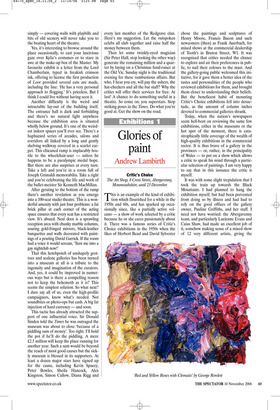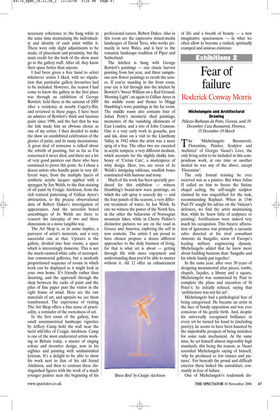Glories of paint
Andrew Lambirth
CriticŌĆÖs Choice
The Art Shop, 8 Cross Street, Abergavenny, Monmouthshire, until 23 December
This is an example of the kind of exhibition which flourished for a while in the 1950s and 60s, and has sparked up occasionally since, like a partially active volcano ŌĆö a show of work selected by a critic because he or she cares passionately about it. There was a famous series of CriticŌĆÖs Choice exhibitions in the 1950s when the likes of Herbert Read and David Sylvester chose the paintings and sculptures of Henry Moore, Francis Bacon and such newcomers (then) as Frank Auerbach, for mixed shows at the commercial dealership of ToothŌĆÖs in Bruton Street, W1. It was recognised that critics needed the chance to explore and air their preferences in public, to nail their colours to the mast. And the gallery-going public welcomed this initiative, for it gave them a better idea of the tastes and personalities of the people who reviewed exhibitions for them, and brought them closer to understanding their beliefs. But the beneficent habit of mounting CriticŌĆÖs Choice exhibitions fell into desuetude, as the amount of column inches devoted to commercial galleries shrank.
Today, when the nationŌĆÖs newspapers seem hell-bent on reviewing the same few exhibitions, either in the museums or the hot spot of the moment, there is catastrophically little coverage of the wealth of high-quality exhibitions in the commercial sector. It is thus brave of a gallery in the provinces ŌĆö or, rather, in the principality of Wales ŌĆö to put on a show which allows a critic to speak his mind through a particular selection of paintings. I am very happy to say that in this instance the critic is myself.
It was with some slight trepidation that I took the train up towards the Black Mountains. I had planned to hang the exhibition myself, but had been prevented from doing so by illness and had had to rely on the good offices of the gallery owner, Pauline Griffiths, and her staff. I need not have worried: the Abergavenny team, and particularly Lucienne Evans and Caius Shaw, had made an excellent job of it, somehow making sense of a mixed show of 12 very different artists, giving the necessary coherence to the hang while at the same time maintaining the individuality and identity of each artist within it. There were only slight adjustments to be made, of placement and proximity, but the main credit for the look of the show must go to the gallery staff. After all, they know their space better than anyone.
I had been given a free hand to select whichever artists I liked, with no stipulation that particular gallery favourites had to be included. However, the reason I had come to know the gallery in the first place was through an exhibition of George Rowlett, held there in the autumn of 2005 after a residency at nearby Capel-y-ffin, and reviewed in these pages. I have been an admirer of RowlettŌĆÖs thick and luscious paint since 1990, and the fact that he was the link made him an obvious choice as one of my artists. I then decided to make the show an uninhibited celebration of the glories of paint, and its many incarnations. A great deal of nonsense is talked about the rebirth of painting, but as far as IŌĆÖm concerned it never died, and there are a lot of very good painters out there who have continued to prove this point. So I chose a dozen artists who handle paint in very different ways, from the multiple layers of synthetic acrylic lacquer applied with a spraygun by Ian Welsh, to the thin staining of oil paint by Craigie Aitchison, from the rich textural patterning of Gillian AyresŌĆÖs abstraction, to the precise observational data of Robert DukesŌĆÖs investigation of appearances. And the surrealist boxed assemblages of Jo Welsh are there to reassert the interplay of two and three dimensions in a more tangible way.
The Art Shop is, as its name implies, a purveyor of artistŌĆÖs materials, and a very successful one at that. Upstairs is the gallery, divided into four rooms, a space which is interestingly domestic. This is not the much-vaunted white cube of metropolitan commercial galleries, but a modestly proportioned sequence of rooms in which work can be displayed as it might look in your own home. ItŌĆÖs friendly rather than daunting, and the approach through the shop between the racks of paint and the piles of fine paper puts the visitor in the right frame of mind. Here are the raw materials of art, and upstairs we see them transformed. The experience of visiting The Art Shop offers a fine sense of practicality, a reminder of the rootedness of art.
In the first room of the gallery, four small unsymmetrical landscape vignettes by Jeffery Camp hold the wall near the lucid still-lifes of Craigie Aitchison. Camp is one of the most underrated artists working in Britain today, a master of singing colour and inventive design, now in his eighties and painting with undiminished lyricism. ItŌĆÖs a delight to be able to show his work next to that of his old friend Aitchison, and then to contrast these distinguished figures with the work of a much younger painter near the beginning of his professional career, Robert Dukes. Also in this room are the expressive mixed-media landscapes of David Tress, who works primarily in west Wales, and is heir to the romantic landscape tradition of Piper and Sutherland.
The kitchen is hung with George RowlettŌĆÖs paintings ŌĆö one classic harvest painting from last year, and three sumptuous new flower paintings to ravish the senses. If youŌĆÖre standing in the front room, your eye is led through into the kitchen by RowlettŌĆÖs ŌĆśSweet William on a Red Ground, Morning LightŌĆÖ, on again to Gillian Ayres in the middle room and thence to Maggi HamblingŌĆÖs wave paintings in the far room. The middle room also contains four of Julian PerryŌĆÖs mesmeric shed paintings, mementos of the vanishing allotments of East London, and a trio of John Craxtons. One is a very early work in gouache, pen and ink, done on a visit to the Llanthony Valley in 1942 when the artist was a mere sprig of a boy. The other two are executed in acrylic tempera, a very different medium, which accounts for the slightly chalky lambency of ŌĆśCretan CatsŌĆÖ, a masterpiece of witty design. Here, too, are seven of Jo WelshŌĆÖs intriguing tableaux, smallish boxes constructed with humour and irony.
Much of the work has been specially produced for this exhibition ŌĆö witness HamblingŌĆÖs brand-new wave paintings, on which the salt spray is scarcely dry ŌĆö and the four panels of the seasons, a very different treatment of water, by Ian Welsh. In one we witness the power of the North Sea, in the other the behaviour of Norwegian mountain lakes, while in Cherry PicklesŌĆÖs distinctive pictures we are on the road in Greece and America, exploring the self in new contexts. The artists I am proud to have chosen propose a dozen different approaches to the daily business of living, for that is what art is about ŌĆö getting through life with more enjoyment and understanding than youŌĆÖd be able to muster without it. All 12 offer an enhancement of life and a breath of beauty ŌĆö a new imaginative spaciousness ŌĆö in what we often allow to become a rushed, spiritually cramped and anxious existence.



































































































 Previous page
Previous page